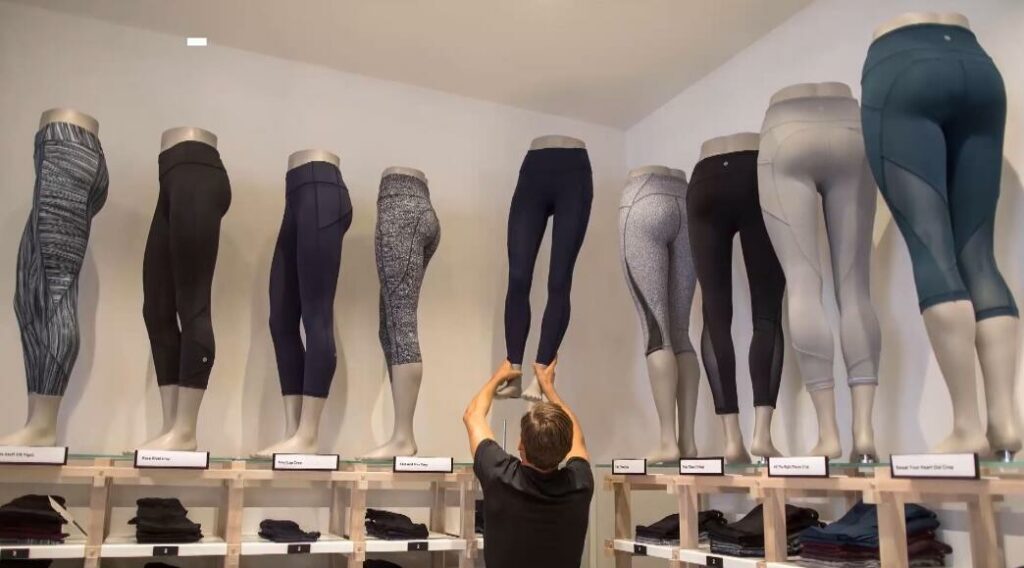The concept of sustainability has found its way into almost all sectors of human life, including fashion. The fashion industry is notorious for its environmental degradation and its impact on the planet. However, the industry has also seen a surge of eco-friendly brands that aim to reduce environmental impact. One such area of environmentally-friendly fashion is eco-friendly and sustainable yoga pants.
This article explores the rise of sustainable and eco-friendly yoga pants brands, and how they are changing the face of the fashion industry. We will delve into the fabrics, manufacturing practices, and packaging of eco-friendly yoga pants to help you understand the importance of sustainability in the fashion industry. We will also introduce you to some of the top eco-friendly yoga pants brands and how they are contributing to the conservation of the planet.
The Growth of Athleisure Trend
The growth of the athleisure trend, which involves wearing athletic clothing designed for workouts as everyday wear, has contributed significantly to the popularity of yoga pants. Athleisure offers a convenient, comfortable, and functional alternative to traditional fashion clothing, and yoga pants are versatile enough to meet the demands of the trend.
This trend became more mainstream in the 2010s with celebrities such as Beyoncé, Rihanna, and Gigi Hadid, sporting athleisure clothing. Today, many people view yoga pants not just as a garment for working out but as a fashion statement. This has led to an increase in demand for trendy and fashionable yoga pants, with designers offering various designs, colors, and fabrics to meet the consumer needs.
The Negative Impact of Traditional Yoga Pants

Polyester and Nylon
Traditional yoga pants are made from non-renewable materials like polyester and nylon, which have a significant impact on the environment. Polyester is derived from petroleum, and the production process involves the consumption of large amounts of water, energy, and chemicals.
On the other hand, nylon is a synthetic fabric made from petrochemicals. Its production involves the release of significant amounts of greenhouse gases that contribute to global warming. Additionally, both nylon and polyester do not degrade easily, leading to accumulation in landfills and oceans, affecting marine life.
Harmful Dyes and Chemicals
The production process of traditional yoga pants also involves the use of harmful dyes and chemicals. The dyes are made from synthetic chemicals that release volatile organic compounds, which can cause respiratory problems among workers in the manufacturing facilities.
Furthermore, the chemicals used to soften, dye, and wrinkle-resist fabrics may pollute the water and soil. The toxic chemicals that end up in waterways can be ingested by marine life, leading to environmental degradation and the decline of aquatic ecosystems.
The Rise of Sustainable and Eco-Friendly Yoga Pants Industry

Awareness for Sustainable and Eco-Friendly Clothing
The fashion industry is notorious for its environmental degradation and negative impact on the planet. However, in recent years, people have become more aware of the importance of sustainable and eco-friendly clothing. Consumers are increasingly demanding transparency from clothing brands, which has led to an increase in sustainable and eco-friendly brands.
According to a report by the Fashion Revolution, consumers are increasingly interested in purchasing sustainable clothing. The report found that 75% of consumers would pay more for more sustainable clothing, and 56% of consumers would pay more for clothes if it meant that workers were paid fair wages and had safe working conditions.
The Impact of Yoga Philosophy
The philosophy of yoga emphasizes harmony with oneself and the environment, which aligns with the principles of sustainability. Many individuals who practice yoga hold the belief that their clothing should reflect their values of mindfulness and respect for the environment.
Therefore, the rise of the sustainable and eco-friendly yoga pants industry can be attributed to the principles of yoga that promote an environmentally conscious lifestyle.
Fabric Materials Used in Sustainable and Eco-Friendly Yoga Pants

Organic Cotton
One of the most commonly used materials in sustainable and eco-friendly yoga pants is organic cotton. It is produced without the use of synthetic pesticides, herbicides, or fertilizers. Organic cotton farming techniques help reduce soil and water pollution. Additionally, organic cotton production is carbon-neutral, which means that it does not contribute to greenhouse gas emissions that impact climate change.
Recycled Polyester
Recycled polyester is another material used in sustainable and eco-friendly yoga pants. Recycled polyester is made from recycled materials like plastic bottles, making it an environmentally responsible choice. The production process of recycled polyester consumes less energy and water than virgin polyester.
Hemp
Hemp is another excellent sustainable alternative for traditional yoga pants. Hemp requires less water and does not require the use of pesticides or fertilizers, making it environmentally friendly. Additionally, hemp fibers are biodegradable and can be used to make comfortable and durable yoga pants.
Tencel
Tencel is a type of lyocell fabric made from sustainable wood pulp. The production process of Tencel consumes less water than traditional cotton production, making it a more environmentally conscious option.
Dyes and Chemicals Used in Sustainable and Eco-Friendly Yoga Pants
Natural and Plant-Based Dyes
Natural and plant-based dyes are an eco-friendly alternative to synthetic dyes. They are made from natural materials like fruits, leaves, and flowers, and do not release harmful chemicals into the environment.
Sustainable and eco-friendly brands use natural and plant-based dyes because they are less polluting and biodegradable.
Non-Toxic Chemicals
Sustainable and eco-friendly brands also use non-toxic chemicals to dye and treat their fabrics. Non-toxic chemicals do not pollute the water, soil, or air as much as conventional chemicals used in traditional dyeing. Additionally, non-toxic chemicals are safer and healthier for the workers and the environment.
Sure, here are the next sections:
Introducing Eco-Friendly Yoga Pants Brands
There are various brands of eco-friendly yoga pants that are worth mentioning. In this section, we will look at some of the most popular eco-friendly yoga pants brands, their descriptions, and the pros and cons of each brand.
Brand 1: Manduka
Manduka is a well-known yoga accessories company that also offers a wide range of eco-friendly yoga pants. The brand uses sustainable and biodegradable materials such as organic cotton, recycled polyester, and Tencel.
Pros:
- Manduka offers a wide range of eco-friendly yoga pants designs, colors, and styles.
- The company uses sustainable and biodegradable materials that are gentle on the environment.
- The pants are durable and long-lasting, reducing the need for frequent replacements.
Cons:
- Manduka’s eco-friendly yoga pants are relatively expensive compared to traditional yoga pants.
- Some customers report that the sizing is inconsistent, which makes it challenging to choose the right size.
Brand 2: Teeki
Teeki is a sustainable activewear brand that offers various eco-friendly yoga pants made from recycled plastic bottles.
Pros:
- Teeki’s eco-friendly yoga pants are made from recycled plastic bottles, making them an environmentally responsible choice for consumers.
- The pants are very comfortable to wear, which makes them perfect for long yoga sessions.
- Teeki offers a wide range of colorful and stylish designs that are suitable for various occasions.
Cons:
- Some customers report that the pants are not very durable and may wear out after a few uses.
- Some of the designs may not be suitable for all body shapes and sizes.
Brand 3: Satva
Satva is an eco-friendly and fair trade activewear brand that offers organic and sustainable yoga pants.
Pros:
- Satva’s eco-friendly yoga pants are made from sustainable and organic materials such as organic cotton and recycled polyester.
- The company promotes fair trade and ethical labor practices, which ensures that the workers producing the pants are paid and treated fairly.
- Satva’s eco-friendly yoga pants are very comfortable and durable.
Cons:
- Some customers report that the sizing can be inconsistent, which makes it challenging to choose the right size.
- Some of the designs may not be as trendy or fashionable as other eco-friendly yoga pants brands.
Brand 4: Wolven Threads
Wolven Threads is an eco-friendly and sustainable activewear brand that offers a range of stylish and fashionable yoga pants made from recycled plastic bottles.
Pros:
- Wolven Threads’ eco-friendly yoga pants are stylish and fashionable, making them perfect for everyday wear.
- The brand uses recycled plastic bottles to make the pants, making them an environmentally responsible choice for consumers.
- The pants are very comfortable and provide optimal support during yoga sessions.
Cons:
- Wolven Threads’ eco-friendly yoga pants are relatively expensive compared to traditional yoga pants.
- Some customers report that the pants may not be as durable as other eco-friendly yoga pants brands and may wear out after a few uses.
Brand 5: PrAna
PrAna is an eco-friendly and sustainable activewear brand that offers a range of functional and high-quality yoga pants made from sustainable materials such as organic cotton and recycled polyester.
Pros:
- PrAna’s eco-friendly yoga pants are durable and long-lasting, which reduces the need for frequent replacements.
- The company promotes sustainable and ethical practices, ensuring that the production process is gentle on the environment and that the workers are treated fairly.
- PrAna offers a wide range of styles and designs that are suitable for various occasions, making them versatile pants for any wardrobe.
Cons:
- PrAna’s eco-friendly yoga pants are relatively expensive compared to traditional yoga pants.
- Some customers report that the sizing is inconsistent.
Other Noteworthy Eco-Friendly Yoga Pants Brands
Other noteworthy eco-friendly yoga pants brands include Beyond Yoga, Girlfriend Collective, Yoga Democracy, and Liquido Active. All of
these brands are committed to using sustainable and eco-friendly materials and manufacturing practices in their production process. Beyond Yoga offers a range of yoga pants made from recycled polyester and organic cotton. Girlfriend Collective uses recycled water bottles to create its eco-friendly leggings while promoting ethical labor practices. Yoga Democracy offers high-quality yoga pants made from sustainable materials such as recycled polyester and Tencel. Liquido Active uses biodegradable and eco-friendly materials to create its stylish and comfortable yoga pants.
Overall, the rise of eco-friendly and sustainable yoga pants brands has contributed significantly to the fashion industry’s shift towards more sustainable practices. Consumers can now purchase high-quality, durable, and stylish yoga pants without compromising the environment. The rise of sustainable and eco-friendly yoga pants emphasizes the importance of making conscious and responsible choices towards our planet.
Conclusion
In conclusion, eco-friendly and sustainable yoga pants are a crucial part of the fashion industry’s movement toward sustainability and ethical practices. The increasing demand for sustainable clothing has led to many innovative and eco-friendly yoga pants brands that utilize biodegradable and sustainable materials along with ethical manufacturing practices.
Consumers also play a role in the adoption of sustainable and eco-friendly yoga pants by choosing to purchase from brands that prioritize environmental and social responsibility. As consumers become more conscious of the environmental impact of clothing, sustainable clothing options like eco-friendly yoga pants will continue to rise in popularity.
We can make a difference by choosing eco-friendly yoga pants over traditional ones. By doing so, we are making a conscious effort towards a more sustainable future.
